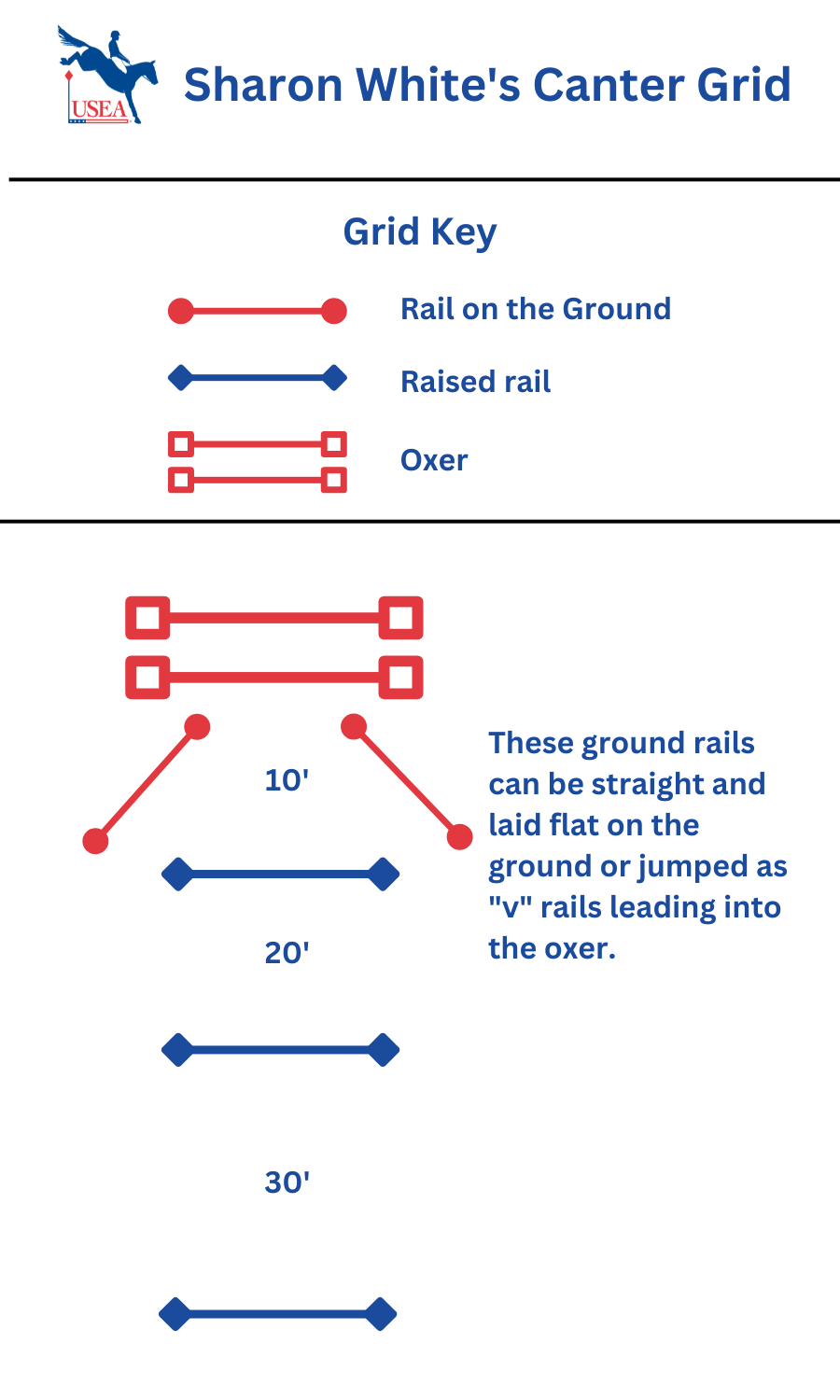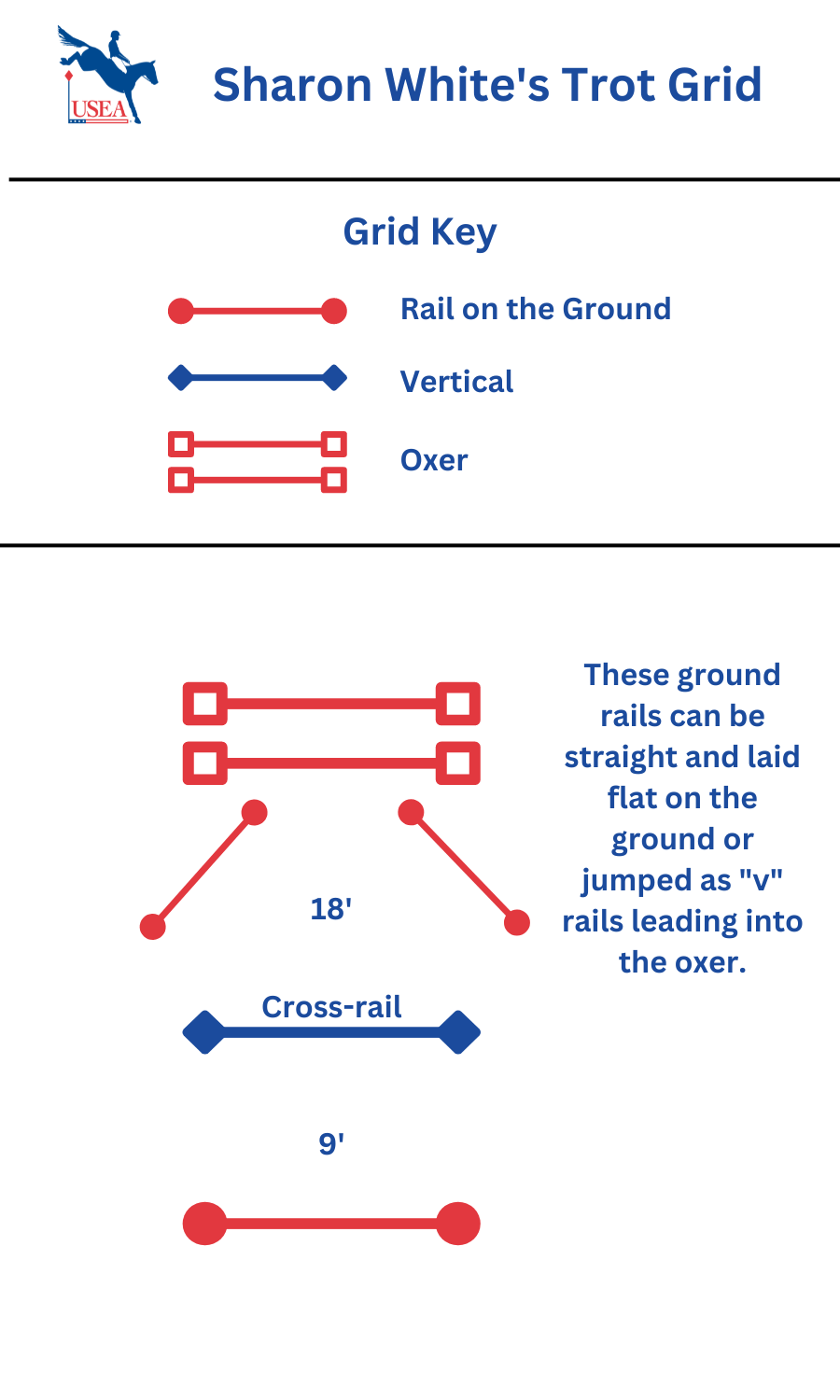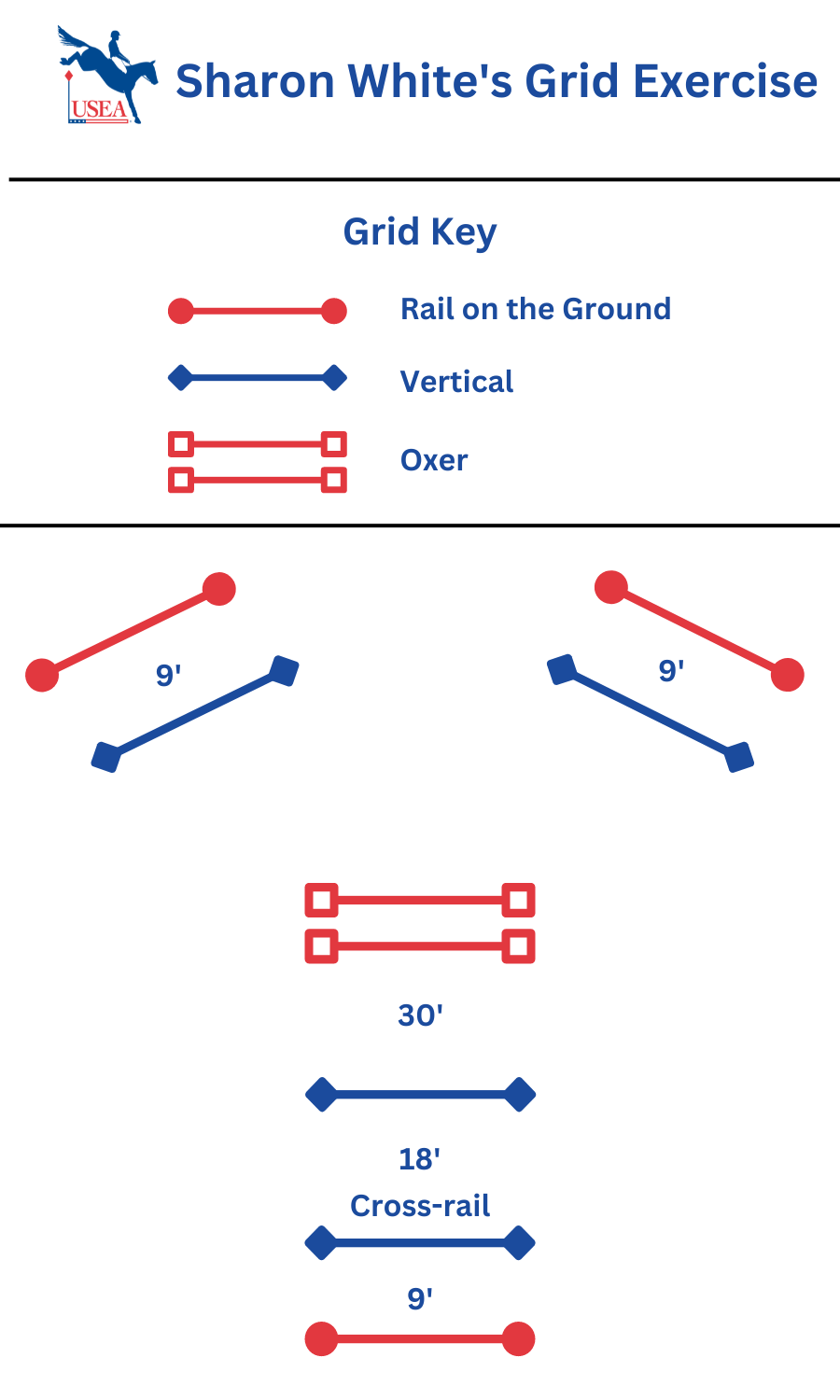Renew Your USEA Membership for the 2023 Season Today LEARN MORE

As complex as eventing can be through the various lines and tracks presented to horses and riders in the jumping phases, gridwork can help make things simpler when in the heat of the moment of a competition, clinic, or lesson. Regardless of the level, gridwork teaches horses and riders to establish the rhythm they will need and the feeling they get from successfully riding a line of jumps.
“Gridwork is education for both horse and rider,” said Sharon White, who has brought up multiple horses to the five-star level and is a Level V USEA Eventing Coaches Program (ECP) Certified Coach. “To me, gridwork is where an exercise does the work for you. So, for horses, that’s a beautiful thing.”
Gridwork involves placing a combination of jumps, cross-rails, cavaletti, and ground poles in succession to set horses and riders up for success over a jump, rather than having a jump be a standalone feature where they're left to their own devices on the approach to it.
In its most basic form, a grid can involve ground poles placed at distances that assist in establishing and maintaining the rhythm at the trot or at the canter that is needed to take the jump placed at the end of a grid. From there, a grid can become more complex to include multiple jumps that build on each other. However, the goal of having horses and riders move smoothly through the grid remains the same.
“Basically, once you’re in it, you’re following the motion,” White said. “It’s a little bit like going to the gym and using a machine to help you versus having to do it all on your own with body weight.”

For example, in what White calls “my favorite canter grid” because “it gives you the perfect canter stride to a jump,” raised rails are placed 30' and then 20' apart with a jump 10' after the final raised rail. That helps adjusts a horse’s canter, much like a machine at the gym guides a person’s range of motion.
“Those are things you have to feel so that you can then produce them yourself at any jump,” White said. “Gridwork puts a horse in good form, and I just find that super useful. And then, it really helps riders teach them a balance point without them having to worry about the perfect distance per se because the exercise is doing that for them. So, it teaches a feeling of what is a good canter, what is a good balance point, what is a good jump. It teaches a feeling really easily, and I like when things are simple.”
Depending on the experience of the horse, a grid can start as a rail on the ground that can be followed with a progression to a cross-rail, then a vertical, and then an oxer.

White’s trot grid places a cross-rail 9' past a ground pole, followed by an oxer placed 18' past the cross-rail.
“Whether you're trotting in or cantering in to any grid, your job is to steer and maintain a rhythm,” White said. “Then, it is the horse’s job to figure out the footwork. The point of educating them with gridwork is that it gives them a chance to figure things out.”
While White has her grid exercises of choice, particularly those presented by Jimmy Wofford, a mentor of hers, in his 2001 book, "Gymnastics: Systematic Training for Jumping Horses," she emphasizes that there can be variability in the grids and in the distances between elements in a particular grid. “A million different versions” is how White described it.
“At the end of the day, it doesn’t actually matter what it is if the principles stay the same because it’s all good footwork to horses,” she said. “If you keep them straight and rhythmical, they’re going to learn something from it.”

Gridwork can be part of a training regiment at any point during the year, but White said she places particular emphasis on utilizing gridwork during the off-season from competition.
“I’m big with my gridwork in the winter,” she said. “When I bring them back into jumping form, that’s what we do. Then, throughout the year, I will do gridwork a couple times a month, or if I have younger horses, I will do it more often. Sometimes after going cross-country, the best thing you can do for an older horse is let them cruise through an easy grid because it resets their balance.”
With the goal of setting up horses and riders to be successful through a grid, White utilizes straight rails on the ground or “v” rails leading into a jump to guide the path through a grid.
“You’re trying to put muscle memory or nerve memory for horses and riders,” she said. “Using guide posts like straight rails to keep them straight puts in the memory, the repetition of good straightness. So, I do that with my exercises all of the time. I don’t consider it a crutch at all; I consider it wonderful muscle memory.”
There's a range in the amount of time it can take for a horse and rider to grasp the muscle memory and feeling intended by a grid exercise.
“Repetition is the mother of all skills until they own it, but they can own it after time no. 1,” White said. “If they own it after time no. 1, stop. If they need to do it 10 times in a row, do it 10 times in a row.”
So, the focus should be on that end goal rather than on the grid itself.
“What people do is their horses are really good, and they just keep going and going and going, and then when they’re bad, they want to stop and talk about it,” White said. “Well, you want to do the opposite. When your horse is good, stop, give them a pat, say, ‘Good job,’ and that’s all you’ve got to do.”
Then, that successful feeling can be something horses and riders will be able to recall in the heat of the moment when they're in the middle of a show jumping course.
About the USEA Eventing Coaches Program (ECP)
Coaches are essential to the training of riders and horses for safe and educated participation in the sport of eventing. The USEA Eventing Coaches Program (ECP), formerly known as the Instructor's Certification Program (ICP), was initiated in 2002 to educate all levels of eventing coaches with crucial training principles upon which those instructors can continue to build throughout their teaching careers. ECP offers educational workshops and assessments by which both regular coaches, Level I through Level V, Young Event Horse (YEH) instructors, and Young Event Horse professional horse trainers can become ECP certified. Additional information about ECP’s goals, benefits, workshops, and assessments as well as names and contact information for current ECP-certified coaches, YEH coaches, and YEH professional horse trainers are available on the USEA website. Click here to learn more about the Eventing Coaches Program.